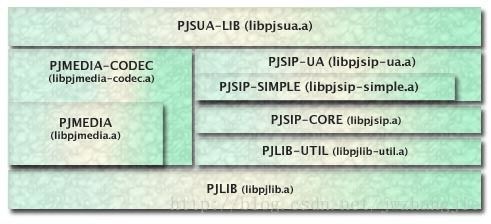pjsip视频通信开发(底层实现)之用户注册(1)
一、PJSIP简介
对于pjsip的介绍可以看http://www.cnblogs.com/my_life/articles/2175462.html 文章,里面详细介绍了它的组成框架以及各部份的组成介绍,我把官网中提供的一个pjsip的整体框架图贴到这里
二、simple_pjsua.c分析
我今天要实现的是UA这部份内容,主要作用可以查看http://www.cnblogs.com/flyfish10000/category/268759.html 里面有作者一系列关于UA的介绍,这里我要实现的是帐号的注册,要做这个我们可以看一下官网一个提供的例子simple_pjsua.c (pjsip-apps/src/samples/),它的内容如下:
/**
* simple_pjsua.c
*
* This is a very simple but fully featured SIP user agent, with the
* following capabilities:
* - SIP registration
* - Making and receiving call
* - Audio/media to sound device.
*
* Usage:
* - To make outgoing call, start simple_pjsua with the URL of remote
* destination to contact.
* E.g.:
* simpleua sip:user@remote
*
* - Incoming calls will automatically be answered with 200.
*
* This program will quit once it has completed a single call.
*/
#include
#define THIS_FILE "APP"
#define SIP_DOMAIN "example.com"
#define SIP_USER "alice"
#define SIP_PASSWD "secret"
/* Callback called by the library upon receiving incoming call */
static void on_incoming_call(pjsua_acc_id acc_id, pjsua_call_id call_id,
pjsip_rx_data *rdata)
{
pjsua_call_info ci;
PJ_UNUSED_ARG(acc_id);
PJ_UNUSED_ARG(rdata);
pjsua_call_get_info(call_id, &ci);
PJ_LOG(3,(THIS_FILE, "Incoming call from %.*s!!",
(int)ci.remote_info.slen,
ci.remote_info.ptr));
/* Automatically answer incoming calls with 200/OK */
pjsua_call_answer(call_id, 200, NULL, NULL);
}
/* Callback called by the library when call's state has changed */
static void on_call_state(pjsua_call_id call_id, pjsip_event *e)
{
pjsua_call_info ci;
PJ_UNUSED_ARG(e);
pjsua_call_get_info(call_id, &ci);
PJ_LOG(3,(THIS_FILE, "Call %d state=%.*s", call_id,
(int)ci.state_text.slen,
ci.state_text.ptr));
}
/* Callback called by the library when call's media state has changed */
static void on_call_media_state(pjsua_call_id call_id)
{
pjsua_call_info ci;
pjsua_call_get_info(call_id, &ci);
if (ci.media_status == PJSUA_CALL_MEDIA_ACTIVE) {
// When media is active, connect call to sound device.
pjsua_conf_connect(ci.conf_slot, 0);
pjsua_conf_connect(0, ci.conf_slot);
}
}
/* Display error and exit application */
static void error_exit(const char *title, pj_status_t status)
{
pjsua_perror(THIS_FILE, title, status);
pjsua_destroy();
exit(1);
}
/*
* main()
*
* argv[1] may contain URL to call.
*/
int main(int argc, char *argv[])
{
pjsua_acc_id acc_id;
pj_status_t status;
/* Create pjsua first! */
status = pjsua_create();
if (status != PJ_SUCCESS) error_exit("Error in pjsua_create()", status);
/* If argument is specified, it's got to be a valid SIP URL */
if (argc > 1) {
status = pjsua_verify_url(argv[1]);
if (status != PJ_SUCCESS) error_exit("Invalid URL in argv", status);
}
/* Init pjsua */
{
pjsua_config cfg;
pjsua_logging_config log_cfg;
pjsua_config_default(&cfg);
cfg.cb.on_incoming_call = &on_incoming_call;
cfg.cb.on_call_media_state = &on_call_media_state;
cfg.cb.on_call_state = &on_call_state;
pjsua_logging_config_default(&log_cfg);
log_cfg.console_level = 4;
status = pjsua_init(&cfg, &log_cfg, NULL);
if (status != PJ_SUCCESS) error_exit("Error in pjsua_init()", status);
}
/* Add UDP transport. */
{
pjsua_transport_config cfg;
pjsua_transport_config_default(&cfg);
cfg.port = 5060;
status = pjsua_transport_create(PJSIP_TRANSPORT_UDP, &cfg, NULL);
if (status != PJ_SUCCESS) error_exit("Error creating transport", status);
}
/* Initialization is done, now start pjsua */
status = pjsua_start();
if (status != PJ_SUCCESS) error_exit("Error starting pjsua", status);
/* Register to SIP server by creating SIP account. */
{
pjsua_acc_config cfg;
pjsua_acc_config_default(&cfg);
cfg.id = pj_str("sip:" SIP_USER "@" SIP_DOMAIN);
cfg.reg_uri = pj_str("sip:" SIP_DOMAIN);
cfg.cred_count = 1;
cfg.cred_info[0].realm = pj_str(SIP_DOMAIN);
cfg.cred_info[0].scheme = pj_str("digest");
cfg.cred_info[0].username = pj_str(SIP_USER);
cfg.cred_info[0].data_type = PJSIP_CRED_DATA_PLAIN_PASSWD;
cfg.cred_info[0].data = pj_str(SIP_PASSWD);
status = pjsua_acc_add(&cfg, PJ_TRUE, &acc_id);
if (status != PJ_SUCCESS) error_exit("Error adding account", status);
}
/* If URL is specified, make call to the URL. */
if (argc > 1) {
pj_str_t uri = pj_str(argv[1]);
status = pjsua_call_make_call(acc_id, &uri, 0, NULL, NULL, NULL);
if (status != PJ_SUCCESS) error_exit("Error making call", status);
}
/* Wait until user press "q" to quit. */
for (;;) {
char option[10];
puts("Press 'h' to hangup all calls, 'q' to quit");
if (fgets(option, sizeof(option), stdin) == NULL) {
puts("EOF while reading stdin, will quit now..");
break;
}
if (option[0] == 'q')
break;
if (option[0] == 'h')
pjsua_call_hangup_all();
}
/* Destroy pjsua */
pjsua_destroy();
return 0;
} 1、一开始是回调使用的函数,例如on_incoming_call当来电话的时候,pjsip会自动去调用你写的这个函数,前提是你在初始化pjsua的时候设置了on_incoming_call = &on_incoming_call,
2、error_exit退出应用所需要的操作
3、main函数:
(1)pjsua_create()创建pjsua的第一步,如果是要打电话要确认URL是否是正确的pjsua_verify_url
(2)初始化pjsua,pjsua_config_default(&cfg)来初始化配置,然后设置一些回调函数,设置日志,最后初始化pjsua_init(&cfg, &log_cfg, NULL);
(3)创建UDP的传输,设置端口号
(4)接下来就是启动pjsua,通过pjsua_start();
(5)创建账户,这个是这篇文章的主要内容,pjsua_acc_config_default初始化配置,然后设置相关的内容,id对应这url,realm是服务器的域名,还有密码和用户名,最后调用 pjsua_acc_add(&cfg, PJ_TRUE, &acc_id);来实现帐号的注册。
4、打电话,上面也提到过,你打电话的话需要验证URL是否正确的 pjsua_verify_url,然后调用pjsua_call_make_call来打电话。
5、挂电话,调用 pjsua_call_hangup_all();
6、最后销毁,pjsua_destroy();
